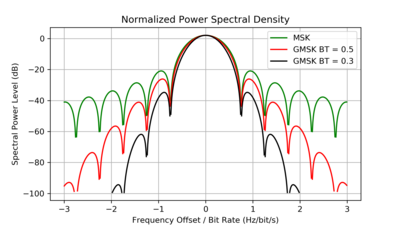Minimum-shift keying
| Passbandmodulation |
|---|
 |
| Analog modulation |
| Digital modulation |
| Hierarchical modulation |
| Spread spectrum |
| See also |
Indigital modulation,minimum-shift keying(MSK) is a type ofcontinuous-phasefrequency-shift keyingthat was developed in the late 1950s byCollins Radioemployees Melvin L. Doelz and Earl T. Heald.[1]Similar toOQPSK,MSK is encoded with bits alternating betweenquadrature components,with the Q component delayed by half thesymbolperiod.
However, instead of square pulses as OQPSK uses, MSK encodes each bit as a halfsinusoid.[2][3]This results in a constant-modulus signal (constant envelope signal), which reduces problems caused by non-linear distortion. In addition to being viewed as related to OQPSK, MSK can also be viewed as a continuous-phase frequency-shift keyed (CPFSK) signal with a frequency separation of one-half the bit rate.
In MSK the difference between the higher and lower frequency is identical to half the bit rate. Consequently, the waveforms used to represent a 0 and a 1 bit differ by exactly half a carrier period. Thus, the maximum frequency deviation isδ = 0.5fmwherefmis the maximum modulating frequency. As a result, the modulation indexmis 0.5. This is the smallest FSKmodulation indexthat can be chosen such that the waveforms for 0 and 1 areorthogonal.A variant of MSK calledGaussian minimum-shift keying(GMSK) is used in theGSMmobile phonestandard.
Mathematical representation[edit]
This sectionneeds additional citations forverification.(April 2020) |

The resulting signal is represented by the formula:[3][failed verification]
whereandencode the even and odd information respectively with a sequence of square pulses of duration2T.has its pulse edges onandon.Thecarrier frequencyis.
Using thetrigonometric identity,this can be rewritten in a form where the phase and frequency modulation are more obvious,
wherebk(t)is +1 whenand −1 if they are of opposite signs, andis 0 ifis 1, andotherwise. Therefore, the signal is modulated in frequency and phase, and the phase changes continuously and linearly.
Properties[edit]

Since theminimum symbol distanceis the same as in theQPSK,[7][6]the following formula can be used for the theoreticalbit-error ratiobound:
whereis the energy per one bit,is the noise spectral density,denotes theQ-functionanddenotes thecomplementary error function.
Gaussian minimum-shift keying[edit]

Gaussian minimum-shift keying, or GMSK, is similar to standard minimum-shift keying (MSK); however, the digital data stream is first shaped with aGaussian filterbefore being applied to a frequency modulator, and typically has much narrower phase shift angles than most MSK modulation systems. This has the advantage of reducingsidebandpower, which in turn reduces out-of-band interference between signal carriers in adjacent frequency channels.[9]
However, the Gaussian filter increases the modulation memory in the system and causesintersymbol interference,making it more difficult to differentiate between different transmitted data values and requiring more complex channel equalization algorithms such as anadaptive equalizerat the receiver. GMSK has highspectral efficiency,but it needs a higherpowerlevel thanQPSK,for instance, in order to reliably transmit the same amount ofdata. GMSK is most notably used in theGlobal System for Mobile Communications(GSM), inBluetooth,in satellite communications,[10][11]andAutomatic Identification System(AIS) for maritime navigation.
See also[edit]
- Constellation diagramused to examine the modulation in signal space (not time)
- Gaussian frequency-shift keying
References[edit]
- ^M.L Doelz and E.T. Heald,Minimum Shift Data Communication System,US Patent 2977417, 1958,http://www.freepatentsonline.com/2977417.html
- ^Anderson J. B., Aulin T., Sundberg C. E. Digital phase modulation. – Springer Science & Business Media, 2013. – p.49–50
- ^abProakis, John G. (2001).Digital Communication(4 ed.). McGraw-Hill Inc. pp.196-199.
- ^Proakis J. G. Digital communications. 1995 //McGraw-Hill, New York. – p. 126-128
- ^Anderson J. B., Aulin T., Sundberg C. E. Digital phase modulation. – Springer Science & Business Media, 2013. – p. 49-50
- ^abLink Budget Analysis: Digital Modulation-Part 2-FSK (Atlanta RF)
- ^Haykin, S., 2001. Communication Systems, John Wiley&Sons. Inc. - p. 394
- ^Haykin, S., 2001. Communication Systems, John Wiley&Sons. Inc. - p. 398
- ^Poole, Ian."What is GMSK Modulation - Gaussian Minimum Shift Keying".RadioElectronics.com.RetrievedMarch 23,2014.
- ^Rice, M., Oliphant, T., & Mcintire, W. (2007). Estimation techniques for GMSK using linear detectors in satellite communications. IEEE Transactions on Aerospace and Electronic Systems, 43(4).
- ^Wong, Yen F., et al. "An optimum space-to-ground communication concept for CubeSat platform utilizing NASA space network and near earth network." (2016).
- Subbarayan Pasupathy,Minimum Shift Keying: A Spectrally Efficient Modulation,IEEE Communications Magazine, 1979
- R. de Buda,Fast FSK Signals and their Demodulation,Can. Elec. Eng. J. Vol. 1, Number 1, 1976
- F. Amoroso,Pulse and Spectrum Manipulation in the Minimum (Frequency) Shift Keying (MSK) Format,IEEE Trans.
- "Appendix D – Digital Modulation and GMSK"(PDF).University of Hull.2001-03-13. Archived fromthe original(PDF)on 2004-09-24.
- Link Budget Analysis: Digital Modulation-Part 2-FSK (Atlanta RF)
- Elnoubi, S., Chahine, S. A., & Abdallah, H. (2004, March). BER performance of GMSK in Nakagami fading channels. In Radio Science Conference, 2004. NRSC 2004. Proceedings of the Twenty-First National (pp. C13-1). IEEE.
- Feher, K. (1993, July). FQPSK: A modulation-power efficient RF amplification proposal for increased spectral efficiency and capacity GMSK and Π/4-QPSK compatible PHY standard. In IEEE 802.11 Wireless Access Methods Phys. Layer Spec. Doc.




![{\displaystyle t=[-T,T,3T,\ldots ]}](https://wikimedia.org/api/rest_v1/media/math/render/svg/13a9172df01228649a659486105daaafbbe187d2)
![{\displaystyle t=[0,2T,4T,\ldots ]}](https://wikimedia.org/api/rest_v1/media/math/render/svg/9bac49ff3eb5f073c59a8a2b88a36c09294a8a53)

![{\displaystyle s(t)=\cos \left[2\pi f_{c}t+b_{k}(t){\frac {\pi t}{2T}}+\phi _{k}\right]}](https://wikimedia.org/api/rest_v1/media/math/render/svg/e0bf9845ccc229590a3bf8c2fb3cac760b8f5f5d)








